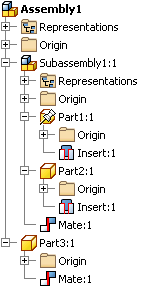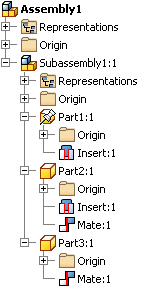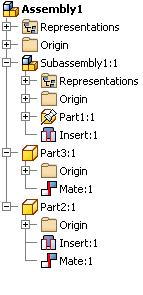Assemblies are composed of parts combined in physical subassemblies. As you design, you often know that a part is needed, but have not yet decided how to group the subassemblies. Using Autodesk Inventor, you can place or create a component in an assembly without worrying where it will reside in the final assembly structure.
You can restructure an assembly by moving parts, groups of parts, component patterns, or entire subassemblies within the browser hierarchy without changing the physical position of previously placed parts.
How is a component moved in the assembly hierarchy?
Components are shown in the browser hierarchy in the order in which you place them. But you can change the component position and the subassembly it belongs to by dragging it within the browser. If you prefer, use the Promote or Demote context menu options to move the component in the browser hierarchy.
Assembly component patterns can also be repositioned using the Promote or Demote context menu options. Component patterns cannot be restructured by dragging.
When you decide to which subassembly the component belongs, you can move it. A component moved from a different assembly is placed, by default, at the bottom of the assembly tree.
In a multiple-user design environment, a file may be in use by someone else or may be locked to prevent changes. To move a component, you must have write privileges for both the origin and target assemblies.
How is component behavior affected by restructuring an assembly?
Keep in mind the following behaviors when you move a component or component pattern to a different subassembly:
- Assembly restructure may affect relationships.
- Adaptive status of the moved component is maintained.
- Enabled, visibility, and color status of the moved component is preserved in named design view representations in the new assembly.
How are relationships affected when an assembly is restructured?
Inventor attempts to maintain relationships between components when the assembly is restructured. In situations where relationships are not maintained, Inventor identifies the relationships as sick ![]() and provides you with tools to repair them such as Show Sick, Free Move, and Design Doctor. (Design Doctor).
and provides you with tools to repair them such as Show Sick, Free Move, and Design Doctor. (Design Doctor).
In general, when assembly relationships are placed, they reside within the lowest parent node common to the components.
- Subassembly1:1 consists of Part1:1 and Part2:1 constrained by the Insert:1 constraint. Note the location of the Insert:1 constraint nodes. The node locations represent constraints between Subassembly1:1 components.
- Subassembly1:1 and Part3:1 are placed in Assembly1. The components are constrained to each other with the Mate:1 constraint (between Part2:1 and Part3:1). However, as the lowest common parent node is Assembly1, the constraint nodes reside at that level and it is not immediately clear to which Subassembly1:1 component Part3:1 is constrained. To view the constraint participants in such cases, you pause the cursor over the Mate:1 constraint in the browser.
For example:
 |
When changes are made to component locations in the browser, Inventor evaluates changes to relationships based on the lowest common parent rule.
Example: Demote a component
- Insert:1 constraint nodes remain at the Subassembly1:1 level as Part1:1 and Part2:1 have not moved.
- Mate:1 constraint nodes now reside within Subassembly1:1, the lowest common parent. You see that Mate:1 is between Part2:1 and Part3:1.
Part3:1 is demoted into Subassembly1:1.
 |
 |
 |
Example: Promote a component
- Insert:1 constraint nodes now reside within Assembly1, the lowest common parent, as Part2:1 is no longer within Subassembly1:1.
- Mate:1 constraint nodes remain within Assembly1, as it is still the lowest common parent.
Part2:1 is promoted out of Subassembly1:1.
 |
 |
 |
General considerations
- The more complex the assembly hierarchy, the more difficult it becomes for Inventor to maintain all relationships. After you restructure your assembly, verify that the relationships still support your design intent.
- When you choose to promote a component such that the number of component occurrences is reduced, Inventor displays a warning message. If you continue the restructure operation, relationships may be orphaned. Orphaned relationships are marked as sick in the browser and should be repaired or replaced.
How are iMates affected when an assembly is restructured?
iMate definition
If the component is moved within or below the assembly where the iMate definition lives, the iMate definition remains stationary and the reference is reconnected to the component. If the component is moved above the assembly where the iMate definition lives, the iMate definition in the source becomes sick since the component can no longer be referenced.
iMate result
In general, the iMate result behaves like an assembly constraint when components are restructured. When changes are made to component locations in the browser, Inventor evaluates changes to the iMate result based on the lowest common parent rule.
- If only one participant in an iMate result is demoted, the iMate definition in the demoted component is copied to the target assembly. However, if the other participant in the iMate result is the target assembly, the iMate result is deleted.
- If only one participant in an iMate result is promoted, the iMate result is moved with the component to the target assembly. The iMate definition in the other component is copied to the source assembly.
- If only one participant in an iMate result is cross-moted, iMate definitions are copied to the appropriate assembly to maintain the iMate result in the lowest common parent assembly.
To support the restructure of iMate results, iMate definitions are updated as follows:
- Use Show Sick, Free Move and the Design Doctor if component changes result in sick iMate results.
- iMate definitions are copied only when their components are participants in an iMate result.
General considerations
How are assembly features affected when an assembly is restructured?
Inventor attempts to preserve and repair assembly features, including assembly sketches, affected by an assembly restructure operation. An assembly feature is considered affected by a restructure operation if any of the restructured components are:
- within an assembly feature's participant list
- used to define the sketch plane for an assembly sketch
- used to associatively project geometry into an assembly sketch
- used to terminate an assembly feature
Assembly features will not be relocated as part of an assembly restructure operation like assembly relationships. Inventor will attempt to repair the affected features in their current location. If the assembly feature can't be repaired because a component is no longer visible to the feature or because the number of occurrences has been reduced by the restructure operation, the Design Doctor is utilized to help you identify and treat the sick features.
How are component patterns affected when an assembly is restructured?
Inventor attempts to automatically repair assembly component patterns affected by an assembly restructure operation. If the pattern is not automatically repaired, it becomes sick and you can decide how best to proceed. An assembly component pattern is affected if any of the following occur:
- a component, used to define a patterns direction or axis of rotation, is restructured
- a component, integral to the patterns ability to find its associated part pattern, is restructured
- a component pattern, using components outside of the pattern that are not restructured, is restructured. The components outside of the pattern are used to define one or more direction vectors or associatively reference a part pattern.